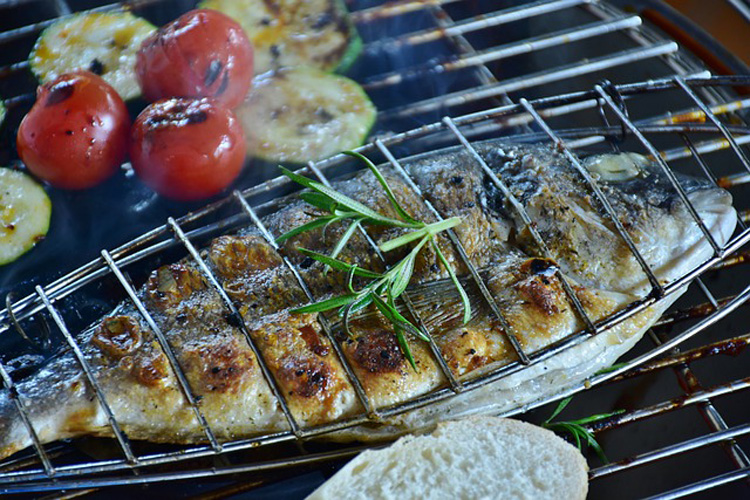The best (and most fun) part about fishing is the feeling after you have caught a fish – or many. Perhaps the worst (and least fun) part of fishing is cleaning your catch. Most anglers are probably familiar with cleaning a fish; but, if you are newer to the sport, this blog can serve as a guide to help while cleaning your catch.
It is recommended to clean your fish within the first couple of hours after they have been caught – but no later than the end of the day, even if you will be freezing them. This is the best way to ensure your catch stays fresh. If you will be out on your boat for more than one day, you will need to clean your fish onboard. If you are just going to be out for a few hours, you can clean your fish on the dock or back on shore. Fortunately, not much is needed for cleaning fish except some background knowledge and a few tools.
Cleaning Fish on a Boat
No matter the size of your boat, it is completely possible to have a set up for fish cleaning. While you can use the lid to your cooler or any flat surface on your boat, there are also filet tables that fit into existing rod holders for space savings. These tables can be adjustable and usually include spaces to store and hold the tools needed for cleaning as well as a ruler to measure your catch. These tables will keep everything contained into one area so that cleanup is a piece of cake. Along with the table, you can also install a plier and knife holder to keep your tools in one spot.
If you would rather just use what you have, that is not a problem. Just be prepared to clean it up afterwards. For cleaning a fish on a boat, you will need a flat surface (i.e. cooler lid or if the back of your boat has a flat landing area), newspaper/plastic wrap, paper towels, a sharp fileting knife, a scaling tool (a butter knife can work too), clean water, a cooler with ice, and a bucket.

Cleaning Fish on a Dock or the Shore
If you would rather wait to clean your fish until you are off of your boat, that is completely possible as well. Cleaning on the dock or shore is typically easiest anyway – it is usually always flat and more stable than a rocking boat. You will need the same items to clean your fish, no matter where you wish to clean them. There are several different steps to cleaning your fish.

Step One: Prepare your Fish
First, you need to set up your cleaning station. You'll want to make sure this space is sanitary and clear enough for you to work in effectively. Lay out your newspaper, towels, and tools so you have quick access to it all while cleaning your fish. You should also have a bucket close by so you can use it to discard parts later.
Now, you will start with rinsing your catch. Use fresh water to clean the slime and other debris off of your fish. Then, you will bleed it for a cleaner process over all. To do this, start by making an incision under the fish's gills. After you have cleaned and bled your fish, use some paper towels to pat the fish as dry as you can. This will make it easier to handle while cleaning and will prevent slips while cutting your fish.
Step Two: Scaling your Fish
The next step is removing the scales (if you wish) from the fish. This is where a butter knife or scaling tool will come in handy. Start by running the knife or tool at the base of the tail all the way up to its head. Repeat this process until the body begins to feel smooth. Rinse the fish to keep clean and get rid of any remaining scales. Gently feel the fish to see if you might have missed any scales; but, be sure to keep an eye out for sharp fins. Continue this process until you have finished the entire fish.
*Note: scales are safe to consume, they just do not taste the best
Step Three: Remove the Entrails
Now, for the knitty gritty of fish cleaning. This is where bleeding your fish earlier in the process will come in handy. To remove the entrails, you will want to make an incision at the base of its tail all the way to its gills along its underside. Make sure to keep the knife shallow, you may ruin the meat if you puncture the intestines.
Once you have made it to the fish head, you can either chop it off, or keep it attached. That is personal preference. Spread the incision open – like a butterfly – and begin removing organs from the abdominal cavity. You will want to cut out the fish's anus with a “V” shaped notch. Make sure to also remove the kidneys, if the fish has them. These will be further up and against its backbone. You will want to scrape the kidney out with a spoon or your thumb. Make sure to remove everything from its abdominal cavity so you can fully enjoy your meal later on.
After cleaning the entrails out, it is time to remove the fins. To remove the dorsal fin, you will want to either cut it off or grab it and swiftly pull it up towards the head. If you decide to remove the fin by pulling it, this will also remove any small bones in the fish.
Now that you have finished gutting your fish and removing fins, carefully and thoroughly rinse out the inside of the fish. Rinse the outside as well in case it got messy during the previous step in the process. You may also want to use a paper towel to do this. Using too much water can wash away flavor from your catch.
When you've finished cleaning, place all of the discarded parts and any trash into your bucket. Feel free to lay down clean newspaper or plastic lining now if you have more fish to clean. Make sure to dispose of your waste properly and thoroughly clean your workstation before leaving.
Preparing to Cook
Now, your fish is ready to be fileted or steaked for cooking. If you wish to filet your fish, start by using your filet knife to pierce the fish behind the gills and pectoral fin. Then, cut down to the spine without severing it. Once you reach the backbone, you will turn your knife and cut down along the spine. This will create a flap from your fish's head to its tail. Pull the flap back as you continue to cut along the backbone. Try to cut as close to the backbone as possible to have the most meat. Repeat this on both sides of the fish. Rinse and blot dry.
If you would rather steak your fish, start by making multiple cuts perpendicular to its backbone. Working from head to tail, cut the fish into half to one inch sections. You will want to cut away bones and fat from the meat. Leave the fish skin and backbone intact.
Before doing any of this, make sure you are preparing a fish that is safe to consume. Some fish are not meant to be eaten because they hold high levels of mercury and heavy metals that are unsafe to ingest. Fish also may have sharp teeth and fins to try and protect themselves, so while cleaning, keep an eye out for those and remove them before ingesting.
Now, you are ready to pansear, grill, or bake your fish filets or steaks. You have a blank slate to create your own culinary masterpiece. Season and prepare your fish to your liking – fresh or frozen. Maybe we lied earlier, tasting your efforts after cooking is probably the best part of fishing.













Comments
Please log into your account to post comments